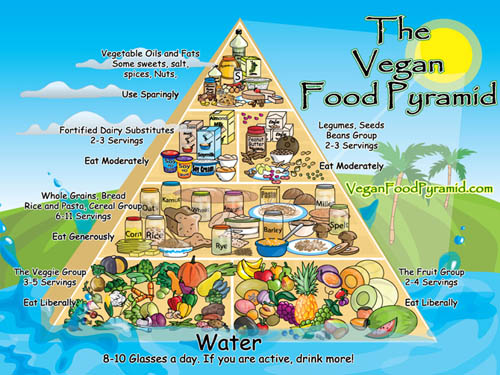Weighing pros and cons of veganism

Photo used with courtesy of Google Commons.
This vegan food pyramid features ar variety of vegan foods to eat in order to have enough nutrients. Foods are featured in ascending order of how much food to eat in different food groups.
In 2020, there is a multitude of different diet options available with health, cultural, ethical and environmental benefits. With vegan and vegetarian diets including a wide variety of these benefits, it seems like a clear choice. However, cutting animal products out of a diet may not be as simple as it seems, with milk, eggs, and meat being in a wide range of foods. With differing benefits and downfalls, it is a complex and personal decision to make.
A big deciding factor in going vegan or vegetarian is all of the animal products in our daily lives. The meat and dairy industries are some of the biggest in the country, and it can be difficult to avoid these ingredients considering the amount of products they are in. “I haven’t tried going vegan or vegetarian yet because I feel like meat and dairy products are foods that most people eat and enjoy in their everyday lives, so it’s hard to give up,” freshman Jessica Chen said.
One thing to consider with eating animal products, specifically cow products such as beef and dairy, is the environmental impact. Cows produce methane, a greenhouse gas that is 84 times more potent than carbon dioxide. Furthermore, the land usage for all animals causes habitats and ecosystems to be destroyed (trees included). “I would go vegan because meat, especially beef, and other animal products associated with cows are incredibly bad for the environment” Senior Alina Sharma said.
Good Housekeeping is a great resource for anyone thinking about or already is vegan or vegetarian with the wide range of vegan recipes and alternative options. With recipes ranging from tofu pad thai, to vegan queso, to pesto pasta, to chocolate chip cookies and everything in between, these recipes can appeal to anybody’s culture and tastebuds.
This chocolate mug cake recipe from The Hungry Blonde is keto-friendly and grain-free, making it suitable for different types of people and diets. With the six simple ingredients of almond flour, cocoa powder, coconut sugar, baking powder, salt, and a flax replacement, this recipe is suitable for first-time bakers. For those allergic to nuts, the almond flour and coconut sugar can be replaced with an alternative such as brown sugar, oat flour, or all-purpose flour. These ingredients can be found at a local grocery store such as Trader Joe’s, Giant, Whole Foods, etc. For the full recipe, go to Hungry Blonde Mug Cake.
When discussing veganism or vegetarianism, food desserts should be a vital part of the conversation. Food deserts are areas where healthy and whole foods are not easily accessible, which in turn could make adapting any diets difficult. Buying in bulk, visiting farmers’ markets, starting a garden, and buying low-cost staples from convenience stores are effective ways to combat this. According to the Economic Research Center of the United States Department of Agriculture, “Relative to all other census tracts, food desert tracts tend to have smaller populations, higher rates of abandoned or vacant homes, and residents who have lower levels of education, lower incomes, and higher unemployment.”
Your donation will support the student journalists of Thomas S. Wootton High School. Your contribution will allow us to purchase equipment and cover our annual website hosting costs.
Dylan is a 2023 graduate.






